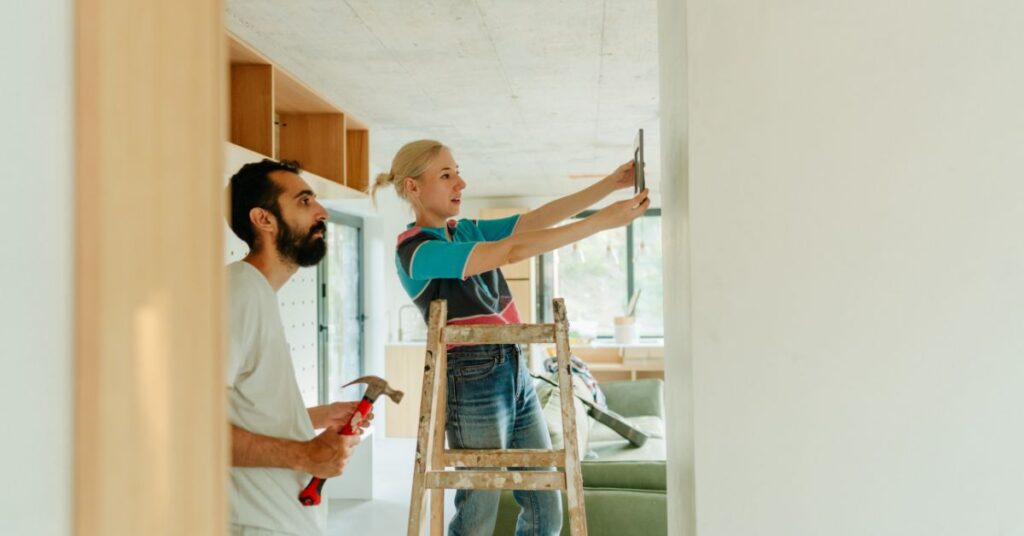Introduction
Home improvement is one of the most popular and rewarding ways to add value, comfort and functionality to your living space. From painting your kitchen cabinets to updating your bathroom fixtures to converting your attic into a spare bedroom—doing it yourself (DIY) can be immensely satisfying—and cost-effective.
But there’s another, less glamorous side to home improvement. Let’s face it, it can also be a very dangerous and injury-prone activity.
Royal Society for the Prevention of Accidents (RoSPA) estimates thousands of people are treated in A&E each year from DIY-related injuries. These include falls and lacerations, to burns and shocks from working with electricity and chemicals.
What’s the safest way to do home improvement? This complete guide is your step-by-step reference for reducing and preventing risks to you and your family—and making every home project a success.
Start with a Clear Plan and Scope
One of the first things most DIY enthusiasts learn is jumping into a job with no plan is a surefire way to create a mess. It’s also a quick way to get hurt.
Planning also prevents last-minute accidents—like dropping a heavy ladder, finding an unstable joist, or forgetting to put on safety goggles.
✅ How to Plan Safely:
- Define Your Goals: Is your project cosmetic (painting, carpeting, etc.), structural (wall removal, underpinning foundations), or both?
- Create a Checklist: List all the steps of the job, from preparation to cleanup. Include tools, materials, time required, and estimated cost.
- Inspect the Work Space: Survey the area for any hidden dangers (see list below).
🛑 Safety Tip:
Never start a DIY task until you’re sure you know what you’re doing. When in doubt, ask a professional or do some more research.
Get the Right Permits and Inspections
Permits can be a nuisance, but they’re not there to frustrate you—they’re there to keep you safe. They also protect you when it’s time to sell your home, or if you need to make an insurance claim.
🧾 Why Permits Matter:
- Safety and Building Code Compliance: Prevents shoddy work that could put you at risk from fire, electricity, and structural damage.
- Third-Party Verification: Professional inspectors catch mistakes before they turn into hazards or lawsuits.
- Insurance and Resale Value: Improper work or no permits can void your insurance and lower your home’s value.
🔧 Projects That May Need Permits:
- Electrical rewiring
- New plumbing installations
- Wall removals
- Roof replacements
- Loft and garage conversions
- Structural changes and extensions
👉 Tip for UK homeowners: Check with your local council or visit Planning Portal UK to see if you need planning permission—or fall under Permitted Development Rights.
Also Read: – What is a home renovation that anybody can do?
Use the Right Personal Protective Equipment (PPE)
PPE isn’t just for hardhats on building sites, it’s for anyone who’s working in or around dangerous conditions. Don’t be fooled by the simplicity of tasks like drilling holes or applying wood glue. There are real risks.
🛡️ Essential Safety Gear:
| PPE Item | Purpose |
|---|---|
| Safety Goggles | Protects from flying dust, debris, paint and chemical splashes |
| Work Gloves | Guards against cuts, burns, abrasions and chemicals |
| Dust Mask/Respirator | Filters out airborne particles when sanding or spray-painting |
| Steel-Toe/Non-Slip Boots | Prevents foot injuries and slipping |
| Ear Protection | Preserves your hearing when using power saws, sanders and drills |
🛑 Safety Tip:
Don’t skimp on PPE for “quick” jobs. It only takes a second to get a drill bit in your eye.
Know Your Tools—And Use Them Properly
Novice misuse is the leading cause of home DIY injuries. Turning a hammer into a drill, or a screwdriver into a chisel could end with you in A&E.
🔧 Tool Safety Best Practices:
- Read the Manual: Learn how to use a tool before using it.
- Use the Correct Tool: Don’t use screwdrivers as chisels, or pliers as hammers.
- Inspect Tools: Check for frayed cords, cracked handles and missing guards.
- Disconnect When Not In Use: Always unplug power tools when not in active use.
- Create a Safe Work Zone: Keep kids, pets, and other distractions out of the work area.
⚠️ Never:
- Use wet hands with power tools
- Remove safety guards
- Leave tools unattended on ladders or work surfaces
Follow Electrical Safety Basics
Electricity can be unforgiving. A small mistake can result in serious burns or shocks, or start a house fire.
⚡ Electrical Dos and Don’ts:
- Switch Off Power: Always shut off the breaker before starting any work.
- Use a Voltage Tester: Double-check wires are not live before touching them.
- Avoid Working in Wet/Damp Conditions: Electricity and water are a lethal combination.
- Label Circuits Correctly: Incorrect breaker labels can cause confusion.
When to Hire an Electrician:
- Adding new outlets, switches or light fixtures
- Installing ceiling fans
- Rewiring your home or fuse box
- Outdoor electrical installations
🛑 Safety Tip (UK only): You must follow Part P of the Building Regulations when carrying out domestic electrical work.
Stay Safe on Ladders and Scaffolding
Falls are the most common cause of DIY-related injuries, so stay off the ground if you can. It’s all about using ladders and scaffolding correctly and sensibly.
🪜 Ladder Safety Checklist:
- Select the right height ladder—don’t overreach
- Three Points of Contact Rule: Always have 2 hands and 1 foot, or 2 feet and 1 hand in contact with the ladder
- Set up on level ground
- Avoid using metal ladders near power lines
- Don’t use a ladder in high winds or rain
Scaffolding Safety:
For tasks that require prolonged work at height, use proper scaffolding. It should always be professionally installed and inspected.
Handle Chemicals, Paints and Adhesives with Care
Paint thinners, wall glues, and other solvents can be very harmful if used incorrectly.
☣️ Chemical Safety Tips:
- Read Product Labels: Follow the instructions and warnings on the packaging.
- Ventilate the Room: Open windows and use fans when using VOC-heavy products.
- Transfer to Sealable Containers: Prevent spills and evaporation.
- Store in a Locked Cabinet: Keep away from heat, flames and children.
- Dispose Responsibly: Don’t pour down the sink or toilet.
Never Mix:
- Bleach and ammonia (forms toxic chloramine gas)
- Cleaning products from different brands, unless it’s safe to do so according to the label
Don’t Work Alone
Don’t feel too big for your boots to ask for some backup when it comes to DIY. If you’re moving heavy furniture, doing electrical or plumbing work, or working at a height, get a friend to help out.
🤝 Why It’s Safer:
- Help with Lifting: Heavy loads are much safer and easier with two people.
- Emergency Assistance: If something goes wrong, you have immediate backup
- Confirmation/Review of Work: A fresh set of eyes can often spot overlooked dangers
If you must work alone, keep your phone close by and let someone know where you are and what you’re doing.
Keep Work Areas Clean and Organized
Disorderly spaces are dangerous spaces. Walk on a nail in the wrong place, trip over a power cord, or lose your balance on a dropped tool and your project will be in big trouble.
🧹 Quick Organization Tips:
- Use Drop Cloths: Keep the mess in one place
- Store tools in a toolbox or on a pegboard
- Vacuum/Sweep Debris Regularly
- Dispose of nails, broken tiles, blades and packaging quickly
- Keep cords, hoses and ladders out of walkways
Working in a clean space boosts productivity and minimizes accidents.
When to Call in the Professionals
DIY is a great way to feel empowered and save money, but not every project is safe for amateurs. Licensed and experienced tradespeople are often the best way to protect yourself, your family, and your wallet.
Call in a Professional for:
- Structural Changes: Removing interior walls, underpinning foundations, reinforcing joists
- Gas Installations/Repairs: New boilers, rerouting pipes, or any work involving gas lines
- Complex Electrical Work: Anything beyond simple fixture replacement
- Roofing: Falls are very common and improper sealing can cause leaks
- Plumbing Overhauls: Mistakes can lead to mould, flooding and costly repairs
Always Check Credentials: Make sure the tradesperson has the proper licenses, insurance and contact references.
Final Thoughts: Safety First, Always
Home improvement is a great way to transform your living space—it also transforms your confidence and comfort. But no matter how skilled or experienced you are, safety should always come first.
By planning ahead, wearing protective gear, handling tools and materials correctly, and knowing when to ask for help—you’ll make every home project not just successful, but safe.
Remember: A safe DIY project is a smart DIY project.
Also Read: – What are some tips, ideas, and trends for home remodeling?
FAQs: Home Improvement Safety
Q1. Can I do electrical work myself at home?
Yes, but only for minor tasks such as changing a light bulb, outlet faceplate, or fixture. New wiring, fuse boxes, and extensions must be done by a qualified electrician. Electrical work must comply with Part P of the Building Regulations in the UK.
Q2. What’s the most common DIY injury?
Ladder-related falls, followed by cuts from power tools and chemical exposure. Take ladder and cutting tool safety very seriously.
Q3. Is PPE necessary for small tasks like sanding or hammering?
Yes, even simple tasks can send wood or metal splinters, dust and debris flying. Always wear goggles and gloves at a minimum.
Q4. How can I check if a wall is load-bearing before removal?
Check your house blueprints or consult with a structural engineer. In most houses, walls that run perpendicular to floor joists are load-bearing. If in doubt, get a professional opinion.
Q5. Is it safer to DIY or hire professionals?
It depends on the job. For simple, cosmetic updates—DIY is perfectly fine (if you take all the necessary precautions). For structural, electrical or gas work—always hire professionals.
Q6. How do I dispose of leftover paint or chemicals?
Never pour them down the drain or toilet. Contact your local council for hazardous waste collection or take to a certified recycling centre.
Stay Safe and DIY Smart
Home improvement can be an incredibly rewarding and productive pastime. But like anything, there are potential hazards and risks that should be taken seriously. By respecting the power of the tools you use, protecting yourself, following regulations, and never being afraid to ask for help—you will create safe, successful projects every time.
Your safety should always be the foundation of any home improvement.

Sunny Saini is a certified heating engineer with over 15 years of experience in maintaining and repairing boilers. He specializes in diagnosing complex boiler issues and providing reliable solutions to ensure homeowners stay warm and comfortable throughout the year.





![]=](https://localboiler.co.uk/wp-content/uploads/2024/05/Untitled-design-96-300x300.jpg)